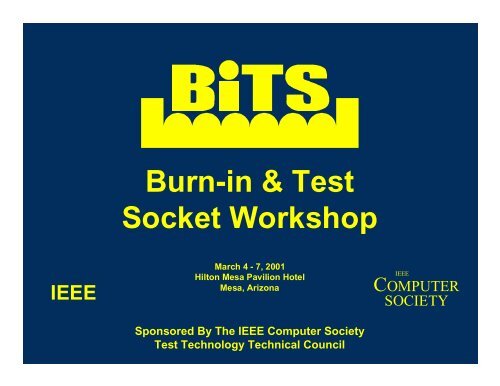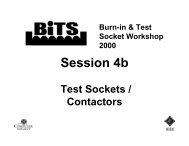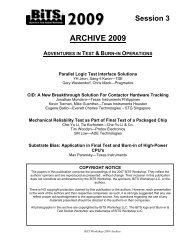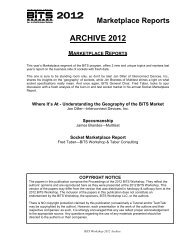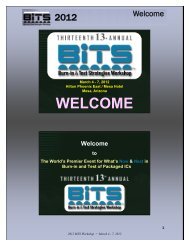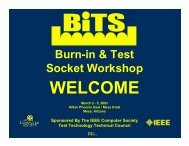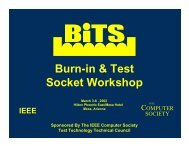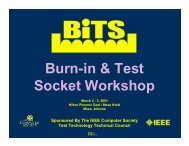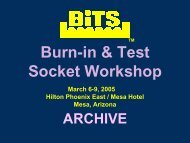Burn-in & Test Socket Workshop - BiTS Workshop
Burn-in & Test Socket Workshop - BiTS Workshop
Burn-in & Test Socket Workshop - BiTS Workshop
- No tags were found...
Create successful ePaper yourself
Turn your PDF publications into a flip-book with our unique Google optimized e-Paper software.
<strong>Burn</strong>-<strong>in</strong> & <strong>Test</strong><strong>Socket</strong> <strong>Workshop</strong>IEEEMarch 4 - 7, 2001Hilton Mesa Pavilion HotelMesa, ArizonaIEEECOMPUTERSOCIETYSponsored By The IEEE Computer Society<strong>Test</strong> Technology Technical Council
COPYRIGHT NOTICE• The papers <strong>in</strong> this publication comprise the proceed<strong>in</strong>gs of the 2001<strong>BiTS</strong> <strong>Workshop</strong>. They reflect the authors’ op<strong>in</strong>ions and are reproduced aspresented , without change. Their <strong>in</strong>clusion <strong>in</strong> this publication does notconstitute an endorsement by the <strong>BiTS</strong> <strong>Workshop</strong>, the sponsors, or theInstitute of Electrical and Electronic Eng<strong>in</strong>eers, Inc.· There is NO copyright protection claimed by this publication. However,each presentation is the work of the authors and their respectivecompanies: as such, proper acknowledgement should be made to theappropriate source. Any questions regard<strong>in</strong>g the use of any materialspresented should be directed to the author/s or their companies.
Technical ProgramSession 8Wednesday 3/07/01 10:30AM<strong>Test</strong> And <strong>Burn</strong>-<strong>in</strong> At The Wafer Level“Wafer Level <strong>Burn</strong>-<strong>in</strong> And <strong>Test</strong>”Teresa McKenzie - MotorolaWalid Ballouli - MotorolaJohn Stroupe - Stroupe Consult<strong>in</strong>g“Some Scenarios On Wafer-Level <strong>Test</strong> & <strong>Burn</strong>-<strong>in</strong>”Robert Y. Million – Yamaichi Electronics USA, Inc.
Agenda / Outl<strong>in</strong>e• Purpose for Develop<strong>in</strong>g Wafer Level <strong>Burn</strong>-<strong>in</strong>• Overview of Wafer Level <strong>Burn</strong>-<strong>in</strong> Methodology• Design Considerations• Accomplishments• Process Improvement Work• Summary<strong>BiTS</strong> 2001 <strong>Workshop</strong>T. McKenzie / W. Ballouli / J. Stroupe2
KGD Sacrificial Metal WLBI• Def<strong>in</strong>ition of Known Good Die (KGD)– Die hav<strong>in</strong>g the same quality and reliability level asthat of an equivalent packaged part.• Def<strong>in</strong>ition of Sacrificial Metal (SM)– Metal which is temporarily deposited on a wafer toprovide electrical signal paths to a die andsurround<strong>in</strong>g die dur<strong>in</strong>g wafer level burn-<strong>in</strong> and test.The sacrificial metal is etched away after burn-<strong>in</strong>and test is complete.<strong>BiTS</strong> 2001 <strong>Workshop</strong>T. McKenzie / W. Ballouli / J. Stroupe3
KGD Sacrificial Metal WLBI• Def<strong>in</strong>ition of Wafer Level <strong>Burn</strong>-In (WLBI)– Simultaneous burn-<strong>in</strong> of all die on a wafer to screenout marg<strong>in</strong>al devices for <strong>in</strong>fant mortality bydynamically stress<strong>in</strong>g the <strong>in</strong>tegrated circuit atelevated temperature and voltage.<strong>BiTS</strong> 2001 <strong>Workshop</strong>T. McKenzie / W. Ballouli / J. Stroupe4
Purpose For Develop<strong>in</strong>gWafer Level <strong>Burn</strong>-In• Industry Requirements– Packag<strong>in</strong>g m<strong>in</strong>iaturization technology driv<strong>in</strong>gneed for Known Good Die (KGD).– Use of flip chips <strong>in</strong> multi-chip modules (MCM),direct chip attach (DCA), and chip-on-board(COB).<strong>BiTS</strong> 2001 <strong>Workshop</strong>T. McKenzie / W. Ballouli / J. Stroupe5
Purpose For Develop<strong>in</strong>gWafer Level <strong>Burn</strong>-In• WLBI Known Good Die (KGD) Benefits– Lower cost method than die level burn-<strong>in</strong>.– Use of KGD flip chips <strong>in</strong> multi-chip modules(MCM), direct chip attach (DCA), and chip-onboard(COB).– Reduction <strong>in</strong> process steps when compared topackaged-level and die-level burn-<strong>in</strong>.– Reduction of wafer test <strong>in</strong>sertion and probe time.– Faster test result feedback to the fab.<strong>BiTS</strong> 2001 <strong>Workshop</strong>T. McKenzie / W. Ballouli / J. Stroupe6
Wafer Level <strong>Burn</strong>-<strong>in</strong> MethodologyPackage <strong>Burn</strong>-<strong>in</strong> / Die-Level <strong>Burn</strong>-<strong>in</strong>Wafer ProbeSacrificial Metal Wafer Level <strong>Burn</strong>-<strong>in</strong>Dic<strong>in</strong>gWLBI andDynamic <strong>Test</strong>AssemblyCarrierLoadWafer Probe(Reduced Time)<strong>Test</strong>AssemblyDic<strong>in</strong>gPackage<strong>Burn</strong>-<strong>in</strong>BCarrier<strong>Burn</strong>-<strong>in</strong><strong>Test</strong><strong>Test</strong>Packaged UnitsKGDCarrierUnloadPackaged UnitsKGD<strong>BiTS</strong> 2001 <strong>Workshop</strong>T. McKenzie / W. Ballouli / J. Stroupe7
Wafer Level <strong>Burn</strong>-<strong>in</strong> MethodologyIC design1X BI metal maskLoad <strong>in</strong> BI fixtureBI circuit designF<strong>in</strong>ished wafersDeposit sacrificialmetal and patternBI circuitKGD<strong>Burn</strong>ed-In wafersand ready fortest<strong>in</strong>g and die prepRemove sacrificialmetalWLBI and <strong>Test</strong> Chamber<strong>BiTS</strong> 2001 <strong>Workshop</strong>T. McKenzie / W. Ballouli / J. Stroupe8
5 <strong>in</strong>ch Wafer Level <strong>Burn</strong>-In MethodologyM2 Ma<strong>in</strong> Bus L<strong>in</strong>e "Ti-W-Cu "Cu M<strong>in</strong>iBumpPolysil iconResistorFieldOxid eM1/M2InterconnectSCRIBEScribe Grid EdgeGRIDM 2 Ma<strong>in</strong> Bus L<strong>in</strong>e "Ti-W-Cu "VSSVDDRECEIVERESETCLOCK<strong>BiTS</strong> 2001 <strong>Workshop</strong>T. McKenzie / W. Ballouli / J. Stroupe10
5 <strong>in</strong>ch Wafer Level <strong>Burn</strong>-In SystemsFirst PrototypeCurrent Production<strong>BiTS</strong> 2001 <strong>Workshop</strong>T. McKenzie / W. Ballouli / J. Stroupe11
8 <strong>in</strong>ch WLBI MethodologyPost wafer fab process (with polyimide)• Deposit, pattern and etch sacrificial metal• Parallel electrical buss<strong>in</strong>g of all die <strong>in</strong> a cluster• Wafer level burn <strong>in</strong> (24 hours @ 125 °C)• Data Retention Bake (24 hours @ 270 °C)• Remove sacrificial metal• Bump (flip chip only)• Wafer probe• Visual, dice and T&R• Ship to customer<strong>BiTS</strong> 2001 <strong>Workshop</strong>T. McKenzie / W. Ballouli / J. Stroupe12
8” WLBI Methodology91 BN 2 AN 2 G E C D N 1 N81C D N A N12N1N710BNE21GBG12NAN1E C N N1 E2N C D1211NG B1D A N N E C12N2N1 B D N A 1 1 G B N D A 12 2612E C 1 NN 1 E BA1N G2N 2E C N N A1N G 1C D N N2 2N G B 1 D N N 1 G B C N N2 25NGECDA21N2ENDA11312B N N N 1 B G2D A NN2E C D A 1 N E N C 2 141 G B N N2G N N12314N1N22B N 1 E C D AG B C N A 1NN21E N D21Cluster Arrangement - Viewed Look<strong>in</strong>g at the Wafer Face<strong>BiTS</strong> 2001 <strong>Workshop</strong>T. McKenzie / W. Ballouli / J. Stroupe13
8 <strong>in</strong>ch Wafer Level <strong>Burn</strong>-In SystemCurrent Production System<strong>BiTS</strong> 2001 <strong>Workshop</strong>T. McKenzie / W. Ballouli / J. Stroupe14
WLBI Design Considerations● Additional scribe area to support burn-<strong>in</strong> circuit<strong>in</strong>terconnect and current limit<strong>in</strong>g resistors● Proper burn-<strong>in</strong> metal width and space to supportphoto and etch process● Proper pogo p<strong>in</strong> pad size for gross waferalignment<strong>BiTS</strong> 2001 <strong>Workshop</strong>T. McKenzie / W. Ballouli / J. Stroupe15
WLBI Design Considerations● M<strong>in</strong>imum die per cluster def<strong>in</strong>ed by the number ofrequired signals, power l<strong>in</strong>es, and grounds.● Metal bus width is designed to support currentdensity requirement● Proper adhesion between burn-<strong>in</strong> circuit metal andpolyimide at elevated temperature (<strong>Burn</strong>-In 125°C/Data Retention Bake 270°C)● Polyimide to support burn-<strong>in</strong> contact over activecircuit● Ma<strong>in</strong>ta<strong>in</strong> alum<strong>in</strong>um pad <strong>in</strong>tegrity after burn-<strong>in</strong>metal removal<strong>BiTS</strong> 2001 <strong>Workshop</strong>T. McKenzie / W. Ballouli / J. Stroupe16
Verification of Alum<strong>in</strong>um Pad IntegrityMechanical <strong>Test</strong> Eng<strong>in</strong>eer<strong>in</strong>g Wafer Control WaferBall Shear (gmf)Average 43.8 43.2High 54.3 51.3Low 31.2 36.7Std Dev 5.1 3.7Tensile Pull (gmf)Average 9.6 8.7High 11.0 10.2Low 7.6 7.3Std Dev 0.8 0.8<strong>BiTS</strong> 2001 <strong>Workshop</strong>T. McKenzie / W. Ballouli / J. Stroupe17
System Design Considerations● Maximum wafer power dissipation undernatural and forced convection● Effect of heats<strong>in</strong>k thickness and shape● Thermal transfer between wafer and heats<strong>in</strong>k● Inlet air temperature● Airflow speed and circulation pattern● Temperature uniformity across the wafer<strong>BiTS</strong> 2001 <strong>Workshop</strong>T. McKenzie / W. Ballouli / J. Stroupe18
Accomplishments•5 <strong>in</strong>ch Wafer Program✔Development began <strong>in</strong> 1992✔Eighteen wafer capacity system built <strong>in</strong> 1994✔Production started <strong>in</strong> 1995✔Full lot capacity production system built <strong>in</strong>1997✔Over 2 million KGD delivered s<strong>in</strong>ce 1995 withno documented non-volatile memory (NVM)field failures<strong>BiTS</strong> 2001 <strong>Workshop</strong>T. McKenzie / W. Ballouli / J. Stroupe19
Accomplishments•8 <strong>in</strong>ch Wafer Program✔S<strong>in</strong>gle eng<strong>in</strong>eer<strong>in</strong>g wafer system built <strong>in</strong>1997✔Successful 8 <strong>in</strong>ch Wafer Level <strong>Burn</strong>-In <strong>in</strong>1997✔Prototype Production system built <strong>in</strong>1998✔Production system built <strong>in</strong> 1999<strong>BiTS</strong> 2001 <strong>Workshop</strong>T. McKenzie / W. Ballouli / J. Stroupe20
Accomplishments•Reliability Studies on WLBI die✔Life stress tests (op life, data retention bake(DRB), temperature cycle, etc …)✔Bump shear tests✔Under-fill adhesion tests<strong>BiTS</strong> 2001 <strong>Workshop</strong>T. McKenzie / W. Ballouli / J. Stroupe21
Accomplishments•Reliability Studies on WLBI fixture✔Uniform temperature control✔Power and signal <strong>in</strong>tegrity✔Pogo p<strong>in</strong> characterization<strong>BiTS</strong> 2001 <strong>Workshop</strong>T. McKenzie / W. Ballouli / J. Stroupe22
Process Improvement Work• Coefficient of Thermal Expansion Match<strong>in</strong>g• Uniform Thermal Control• Cluster Yield Improvement• Wafer Cold <strong>Test</strong><strong>BiTS</strong> 2001 <strong>Workshop</strong>T. McKenzie / W. Ballouli / J. Stroupe23
AcknowledgmentsThe authors would like to acknowledge theteamwork from various Motorola SPS groups andDelta V Instruments that contributed to thedevelopment and cont<strong>in</strong>uous improvement of thissacrificial metal wafer level burn-<strong>in</strong> program(AVSD, SMD, FMTC, MOS12, and MOS5).<strong>BiTS</strong> 2001 <strong>Workshop</strong>T. McKenzie / W. Ballouli / J. Stroupe25
Reference Articles• W. Ballouli, T. McKenzie, and N. Alizy, “Known Good DieAchieved Through Wafer-Level <strong>Burn</strong>-In and <strong>Test</strong>”, 26thIEEE/CPMT IEMT Symposium, October 2000, pp. 153-159.• W. Ballouli, C. Bedd<strong>in</strong>gfield, F. Carney, and R. Nair, “Wafer-Level KGD Technology for DCA Applications”, AdvancedPackag<strong>in</strong>g, September 1999, pp. 26-30.• T. McKenzie, “Wafer Level <strong>Burn</strong>-<strong>in</strong> (WLBI) <strong>Workshop</strong>”,Motorola Internal Publication, November 5, 1997.• W. Ballouli, J. Stroupe, “TSM Approach to Wafer Level <strong>Burn</strong><strong>in</strong>”,Motorola Internal Publication, Motorola AMT Symposium,January 25, 1995.<strong>BiTS</strong> 2001 <strong>Workshop</strong>T. McKenzie / W. Ballouli / J. Stroupe26
For Bits 2001 <strong>Workshop</strong> on <strong>Test</strong> & <strong>Burn</strong>-InSOME SCENARIOS ON WAFER-LEVEL TEST & BURN-INRobert Y. MillionMarket<strong>in</strong>g ManagerYamaichi Electronics U.S.A., Inc.1
Chip Scale Packages (CSP)Chip Scale Packages (CSP) have been thedesign darl<strong>in</strong>gs of advanced packag<strong>in</strong>g, butstart<strong>in</strong>g last year 1999, the trend is on waferlevelpackag<strong>in</strong>g. The follow<strong>in</strong>g five areashave seen significant breakthroughs whichcollectively provide a unique technicalfoundation for a new type of electronicspackage:! Copper metallurgy and low dielectricmaterials for IC development! Wafer-level test & burn-<strong>in</strong> (WLBI)! The use of <strong>in</strong>tegrated passives (IPDs)! Design automation tools! Wafer bump<strong>in</strong>g servicesThis presentation will def<strong>in</strong>e and describesome of the current technologies whichaddress the issues <strong>in</strong>volv<strong>in</strong>g Wafer-level test& burn-<strong>in</strong>, a key element for the entire backendassembly/test function <strong>in</strong> IC production.2
Wafer-Level <strong>Test</strong> & <strong>Burn</strong>-InWafer-level test & burn-<strong>in</strong> = the ‘ultimate<strong>in</strong>terconnect’? Why? Some significantobstacles to overcome <strong>in</strong> realiz<strong>in</strong>g a trulyviable Wafer-level test & burn-<strong>in</strong> system:! A lot of Z-axis bumps and high-density<strong>in</strong>terconnects! CTE match<strong>in</strong>g of contactor to silicon underhigh temperature for long duration! Heavy loads or high-forces to makeelectrical connection! Uniform forces to all of the bumps orcoplanarity issues! A low cost contactor systemThese obstacles only relevant to probe orcontactor portion - just first step towardspractical WLBI system. Subsequently, wehave other issues:3
KGD (Known Good Die)! MCC’s <strong>in</strong>terest <strong>in</strong> KGD began <strong>in</strong> late 1980s! DARPA fund<strong>in</strong>g led to jo<strong>in</strong>t-effort withSematech and MCC Consortia5
Became nucleus for such KGD socket/carriertechnologies as:T.I./M.M.S.’s DieMate® - Aehr<strong>Test</strong>’s DiePak®Yamaichi’s KGD/Gold Dot® Program- Bear Technology/Micron Technology - EPITechnologies EPIK® SystemChip Supply’s TAB system - etc.! Goal of these technologies was to get KGD(test & burn-<strong>in</strong>) down to less than $0.01/p<strong>in</strong>= about parity with that of typical TSOPmemory package.Never reached that goal for numerousreasons:! ‘Handl<strong>in</strong>g’ (load<strong>in</strong>g/unload<strong>in</strong>g) of s<strong>in</strong>gulatedbare die <strong>in</strong> carriers proved too cumbersomeand unwieldy6
High volume throughput, or an automatedKGD system, to achieve KGD at a price ofbelow $25 per site on a <strong>Burn</strong>-In Board (BIB)could never be realized - actual cost wasmore like $40 ~ $125 / site with lots of tool<strong>in</strong>gfor substrates, carriers and sometimessockets - vendors tried to standardize on thesockets.Curtailed the growth of MCMs (Multi-ChipModules) as a major marketMay have actually led to present dayonslaught of CSPs (Chip Scale Packages)! CSPs grow<strong>in</strong>g at 108% from 1997 ~ 2002! More rugged and easier to handle than KGD- elim<strong>in</strong>ates yield losses! <strong>Burn</strong>-<strong>in</strong> sockets cost $25 ~ $45 per site onBIB for lower I/O count memory! High-speed test contactors, if required, cost$1,500 ~ $5,000 each7
! Over 65 different CSP packages from over40 different companies - really hard tostandardize on test & burn-<strong>in</strong> socketsMCC’s commercial project <strong>in</strong> 1995 to evaluatefeasibility of wafer-level burn-<strong>in</strong> for reliabilityscreen<strong>in</strong>g of KGD - several of the WLBIsystems to be shown next were germ<strong>in</strong>atedfrom DARPA/MCC/Sematech consortia effort.8
MotorolaWafer-Level <strong>Burn</strong>-In at Motorola - A Jo<strong>in</strong>tDevelopment Project between Motorola,Tokyo Electron Ltd.(TEL), and W.L. Gore &Associates! Motorola - process development, <strong>in</strong>tegrationand qualification! W.L. Gore - supply<strong>in</strong>g wafer contactormaterials <strong>in</strong> the form of GoreMateIIContactor and Inferno IC Board! Tokyo Electron Ltd. - supply<strong>in</strong>g burn-<strong>in</strong>equipment and automation! Project located at BAT-1 (Bump, Assembly,and <strong>Test</strong>) - Motorola’s <strong>in</strong>tegrated back-endfactory <strong>in</strong> Aust<strong>in</strong>, TX - all operations fromunit probe through f<strong>in</strong>al test are under oneroof.9
MotorolaCurrent F<strong>in</strong>al Manufactur<strong>in</strong>g Flow; WLBIAdvantages; and WLBI F<strong>in</strong>alManufactur<strong>in</strong>g FlowCurrent F<strong>in</strong>al Manufactur<strong>in</strong>g FlowPackaged UnitsKnown Good DieCarrierUnload❏ WLBI Advantages– Product Cost Reduction– Cycle Time Reduction– Capital Cost ReductionWLBI F<strong>in</strong>al Manufactur<strong>in</strong>g FlowPackaged UnitsKnown Good DiePackage<strong>Burn</strong>-<strong>in</strong><strong>Test</strong>Carrier<strong>Burn</strong>-<strong>in</strong><strong>Test</strong>Assembly<strong>Test</strong>Assembly<strong>Test</strong>CarrierLoadDic<strong>in</strong>gWafer ProbeDic<strong>in</strong>gWafer ProbeWaferLevel<strong>Burn</strong>-<strong>in</strong>10
MotorolaWLBI Wafer-Contactor AssemblyWLBI Wafer-Contactor AssemblyInferno TM IC BoardGoreMateII TMContactorChuckDiameter about 50umPitch about 100um11
MotorolaWLBI Beta Development SystemWLBI Beta Development System❏Beta Development system is a 7-wafer system <strong>in</strong>clud<strong>in</strong>g– 7-chamber burn-<strong>in</strong> rack– Aligner for wafer-contactor assembly– WLBI Electronics– System Control ModuleSystem Control ModuleWLBI Electronics<strong>Burn</strong>-In Rack& LifterAlign and Assemble ModuleAligner12
MotorolaWafer Maps at Temperature13
MatsushitaMatsushita WLBI System Overview14
Three Part Structure Probe (TPS):Matsushita! Contactor which provides complianceby utiliz<strong>in</strong>g multi-layered<strong>in</strong>terconnect<strong>in</strong>g wire board, conductiverubber, and a membrane with Z-axisbumps! Control CTE of bumped membrane15
MatsushitaIn conclusion, a first step towards practicalWLBI technology has been realized:! CTE match<strong>in</strong>g of contactor to silicon! The absorption of bump height differences! Uniform pressure with the atmosphericcassette! Firm contacts have been achieved on 2,756bumps which have rema<strong>in</strong>ed stable up to125-C! Goal on membrane/substrate life is 1,000cycles, but they are not there yet.16
FormFactorFormFactor Inc. - Us<strong>in</strong>g Microspr<strong>in</strong>gContacts for Wafer-Level Packag<strong>in</strong>g & <strong>Test</strong>FormFactor has <strong>in</strong>vented a new contacttechnology called a MicroSpr<strong>in</strong>g suited forelectronic applications of a low force, low profile,z-axis, wip<strong>in</strong>g, gold on gold contact.! These are true spr<strong>in</strong>gs requir<strong>in</strong>g around onegram of compression force for every one mil ofdisplacement and exhibit low contact resistance,typically below 30 milliohm5 per contact pair.! They can be used as a f<strong>in</strong>e pitch contact downto pitches of 225 microns, ie., as <strong>in</strong> currentproduction of contact<strong>in</strong>g C4 (Flip chip) arrays of1000's of contacts.! They have been profiled as be<strong>in</strong>g ideally used <strong>in</strong>LGA production sockets and have been used <strong>in</strong>FormFactor’s own Probe Cards to test DRAMsor CPUs at the wafer level.17
FormFactorThe ultimate extension of theirMicroSpr<strong>in</strong>g technology comes <strong>in</strong> the formof their WOW technology or Wafer OnWafer. WOW is the IC <strong>in</strong>dustry’s first backendprocess that provides full wafer levelpackage, burn-<strong>in</strong>, test and module assembly -all steps to be performed on a whole waferthereby reduc<strong>in</strong>g costs.The key element <strong>in</strong> FormFactor’s success isthe MicroSpr<strong>in</strong>g contact which is formed byplac<strong>in</strong>g a specifically designed and shapedwire bond at the desired pad or contactlocation, and then plat<strong>in</strong>g up with a proprietaryprocess the wirebond, transform<strong>in</strong>g it <strong>in</strong>to aspr<strong>in</strong>g.18
FormFactorMicrospr<strong>in</strong>g Contacts on SiliconRe-route TraceMicrospr<strong>in</strong>gSilicon•Microspr<strong>in</strong>gs provide:Temporary (pressure) connection dur<strong>in</strong>g test and <strong>Burn</strong>-<strong>in</strong>Permanent Interconnect <strong>in</strong> the f<strong>in</strong>al product•Microspr<strong>in</strong>gs can be located anywhere on the die surface <strong>in</strong>clud<strong>in</strong>gdirectly on the bond pads19
FormFactorThe WOW Process: A Wafer Level Flow forLow Cost KGDSort 1Laser RepairSort 2AttachSpr<strong>in</strong>gsWafer Level<strong>Burn</strong>-<strong>in</strong> andlong cycletestShort cycle &High FrequencyF<strong>in</strong>al <strong>Test</strong> us<strong>in</strong>gFFI Probe CardInterfaceDic<strong>in</strong>g(Saw)ModuleAssembly& <strong>Test</strong>20
FormFactor’s WLBI SolutionFormFactor Design Approach: “Don’t fight the mechanics”Compliant Contacter: Conform to the waferUse positive pressure to drive contacterClamp<strong>in</strong>g and Cool<strong>in</strong>g MechanismWafer Under <strong>Test</strong>FormFactor Whole Wafer ContacterAir Pressure PlenumUse Compression stop to nullify variations21
FormFactorWLBI Clamp<strong>in</strong>g and Cool<strong>in</strong>g System22
FormFactorCurrent Projects with Three Alternative <strong>Test</strong> Flows:! WLBI and Wafer-Level at speed test - demonstratedwith Teradyne Aires tester and Inf<strong>in</strong>eon’s Rambus dietested at 800MHz (12x faster than any other waferleveltest reported)! Dic<strong>in</strong>g after CSP packag<strong>in</strong>g at wafer-level and us<strong>in</strong>gexist<strong>in</strong>g CSP handlers and test boards with $10~20Yamaichi sockets (x-y registration frame and lid - themicrospr<strong>in</strong>g contact is on the die) <strong>in</strong>stead of high-cost,and high-speed test contactors ($1500~4000).! Package, dice, then assemble <strong>in</strong>to modules - do allburn-<strong>in</strong> and test at the module level. No underfillrequired which makes repair simple. S<strong>in</strong>ce themicrospr<strong>in</strong>gs are self-socket<strong>in</strong>g, one can utilize a usea pressure mounted connection and elim<strong>in</strong><strong>in</strong>ate solderor conductive epoxies altogether.23
GryphicsGryphics®, Inc.In Development: A Controlled Compliance Probewith Generic Applications as a Wafer ProbeAnother Company with quite <strong>in</strong>novative technologyis Gryphics, Inc., located <strong>in</strong> Plymouth, MN. Gryphicsis develop<strong>in</strong>g a patented group of products which<strong>in</strong>corporate low cost and high performance <strong>in</strong>to whatare referred to as Removeable Chip Modules(RCM). These high-density modules can accept awide variety of devices <strong>in</strong> many applications witheach device be<strong>in</strong>g <strong>in</strong>terconnected by a very low<strong>in</strong>ductance Multi-mode Compliance contact system,which is solderless and demateable.The RCM can be used as a prototyp<strong>in</strong>g, test & burn<strong>in</strong>,and production IC socket as well as products<strong>in</strong>tegrat<strong>in</strong>g removeable ICs <strong>in</strong>to high volumeconnector applications.24
GryphicsThe suggested <strong>in</strong>terface below consists of acontrolled compliance Module hav<strong>in</strong>g asuspended contact set to <strong>in</strong>terface with abumped device by means of several contactmembers. The module is to act as the<strong>in</strong>terface to the device, which can be dematedfrom the substrate without solder reflow andsubsequently moved to another location suchas a tester or additional circuit board:25
The follow<strong>in</strong>g is an example ofsuch controlled compliance f<strong>in</strong>epitch <strong>in</strong>terconnect utilized <strong>in</strong> thesame probe module for test<strong>in</strong>gand burn<strong>in</strong>g-<strong>in</strong> multiple devicesites:27
GryphicsUs<strong>in</strong>g this approach, a flex circuit exit rout<strong>in</strong>gcom<strong>in</strong>g off the probe module can lead to edgecard connection or mate directly to testelectronics:28
Aehr <strong>Test</strong> SystemsAehr <strong>Test</strong> Systems - Wafer Level <strong>Burn</strong>-Inand <strong>Test</strong> SystemRecently Aehr <strong>Test</strong> Systems announceddevelopment agreements with NHK Spr<strong>in</strong>gCo., Ltd. of Yokohama, Japan for Full-Waferprobe contactors for WLBI and Electroglas,Inc. for a complete Wafer-Level <strong>Burn</strong>-<strong>in</strong> and<strong>Test</strong> solution. Aehr <strong>Test</strong> has been work<strong>in</strong>g <strong>in</strong>this area for several years with cofund<strong>in</strong>g fromDARPA. This section will describe therequirements for a comprehensive WLBTsystem and the solutions Aehr <strong>Test</strong> Systemshas developed.29
WLBT System RequirementsAehr <strong>Test</strong> Systems30
Aehr <strong>Test</strong> SystemsThe economics and time requirements of thealignment and burn-<strong>in</strong> processes dictate theWLBT System Architecture:! Wafer alignment is short duration but usesexpensive hardware! <strong>Burn</strong>-In process is time extensive! Cartridge based system separates the twoprocesses for best cost effectiveness<strong>Test</strong> Electronics and Software are critical toensure that effective contact is be<strong>in</strong>g made tothe devices:! Must test to ensure electrical connection! Additional time for test is <strong>in</strong>significantcompared to burn-<strong>in</strong> time! Functional test can be cost effective at thisstep of the process31
Aehr <strong>Test</strong> System’ s WLBT system is able tosupport different contactors <strong>in</strong>to its cartridgesystem - experiment<strong>in</strong>g with NHK Spr<strong>in</strong>g probes(12K ~13K), Goremate, and Nano Plexus's fab'd'Electronic Membrane'.Manufactur<strong>in</strong>g Integration and Automation Support isnecessary to <strong>in</strong>tegrate the WLBT system <strong>in</strong>to theproduct flow of the manufactur<strong>in</strong>g l<strong>in</strong>e:! Cassette-to-cassette wafer handl<strong>in</strong>g required! Cartridge handl<strong>in</strong>g <strong>in</strong> fab requires precision fixturesand is best not handled manually! Aehr WLBT system offers semi-automatic handl<strong>in</strong>gat first but automation decisions are on a per<strong>in</strong>stallationbasis32
Motorola Inc. / SPS GroupSacrificial Metal Wafer Level <strong>Burn</strong>-<strong>in</strong> KGDMotorola has been develop<strong>in</strong>g and evaluat<strong>in</strong>g WLBItechnologies s<strong>in</strong>ce the early ‘90s as seen <strong>in</strong> the earlierpresentation on the Motorola/TEL/Gore alliance. Thisparticular development and implementation of 127mmand 200mm Sacrificial Metal Wafer Level <strong>Burn</strong>-In KGD atMotorola is a strategic enabl<strong>in</strong>g technology that allowsMotorola to ma<strong>in</strong>ta<strong>in</strong> a competitive edge <strong>in</strong> the electronicpersonal communications, computer and automotivemarketplace.This has been a jo<strong>in</strong>t effort between teams at:! Motorola Aust<strong>in</strong> - TSG (Transportation Systems Group)! Motorola Chandler - SMD (Strategic Manufactur<strong>in</strong>gDeployment)! Motorola Chandler - MOS 12 Group33
Motorola Inc. / SPS GroupThe WLBI process flow at the wafer-level:! WLBI process flow is identical to packagelevel devices all the way to Metal-3 at theMOS! The special passivation mask enable contactalong the scribe grid whose contactsaccommodate excercis<strong>in</strong>g of the devicedur<strong>in</strong>g burn-<strong>in</strong>! A f<strong>in</strong>al polyimide over-layer acts as a stressbuffer <strong>in</strong> aggressive environments (ie.,automotive) - need to be free of unstablecomponents to prevent outgass<strong>in</strong>g! Wafer-level burn-<strong>in</strong> circuit removalcomprised of wet etch processes withchemistries identical to that used <strong>in</strong> def<strong>in</strong><strong>in</strong>gthe WLBI circuit - TiW and/or Cu must becompletely removed34
<strong>Test</strong> System Design:Motorola Inc. / SPS Group35
Motorola Inc. / SPS GroupThe test system consists of:! Two separate chambers conta<strong>in</strong><strong>in</strong>g 14<strong>in</strong>dividual slots for accept<strong>in</strong>g DUT boards! HDI connector provides signal path betweenthe DUT board and its respective driverboard located <strong>in</strong>ternal to the test platform! All necessary power and drive signals aremade available to the wafer via this <strong>in</strong>terface36
Fixture Design and Contact Technology:The wafer, with the WLBIcircuitry (sacrificial metallayer) applies, sits <strong>in</strong> a fixturewhich supplies properalignment, thermal stress andcreates the electrical testpath.Motorola Inc. / SPS Group! Die on the wafer areelectrically grouped <strong>in</strong>toclusters and share powerand drive signals <strong>in</strong>common37
! Electrical contact is made with the waferthrough the use of pogo p<strong>in</strong>s <strong>in</strong>terfac<strong>in</strong>g withtest pads provided through the WLBIcircuitry applied earlier! Pogo p<strong>in</strong>s specially designed to providerobust electrical and mechanical contact -p<strong>in</strong>s are replaceable <strong>in</strong> the eventperformance becomes degradedMotorola has used this system for severalyears to provide KGD for use as Flip Chip orwire-bonded die <strong>in</strong> the automotive <strong>in</strong>dustryand for provid<strong>in</strong>g non-volatile memory chips.38
Die Product ConsortiumDie Products Consortium (DPC) - KGD <strong>Test</strong>and Reliability Screens MethodsDemonstration ProjectThe Die Products Consortium (DPC) is acooperative effort among several lead<strong>in</strong>gmicroelectronics companies to advance thedevelopment of a support <strong>in</strong>frastructure thatwill accelerate the adoption of die products byelectronic system manufacturers worldwide.Currently, there are seven members<strong>in</strong>volved with the <strong>Test</strong> MethodsDemonstration Project - these <strong>in</strong>clude ChipSupply, IBM, Lucent, Intel, T.I., NationalSemiconductor, and CypressSemiconductor. The Consortium is be<strong>in</strong>gmanaged by MCC, recognized as a globalleader <strong>in</strong> KGD technology.39
The goal of the <strong>Test</strong> Methods DemonstrationProject is to demonstrate that wafer level testand stress screen<strong>in</strong>g methods are effective forthe acceleration and detection of varioustypes of defects.This project will provide a basel<strong>in</strong>e formembers to compare defectivity of their fabswith other members’ experience on a strictconfidential basis.The Project will develop the tools and provideunderstand<strong>in</strong>g of the <strong>in</strong>dustry’s “best practice”,enabl<strong>in</strong>g members to determ<strong>in</strong>e the most costeffective means to achieve their particularreliability goals.40
Contributors1. Flynn, Greg W., “Wafer Level <strong>Burn</strong>-In (WLBI) at Motorola -Outl<strong>in</strong>e” for Fleck Research Chip Scale International 1999.2. Mosko, John, “Full Wafer <strong>Burn</strong>-In and <strong>Test</strong>” from Sixth AnnualKGD <strong>Workshop</strong>, W.L.Gore & Associates, Inc.3. Nakata, Yoshiro and Kawai,Makoto, “A Wafer-Level <strong>Burn</strong>-<strong>in</strong>Technology” from ULSI Process Technology DevelopmentCenter, Matsushita Electronics Corporation.4. Whitten, Ralph, “Us<strong>in</strong>g Microspr<strong>in</strong>g Contacts for WaferLevel Packag<strong>in</strong>g and <strong>Test</strong>” from FormFactor, Inc.5. Rathburn, James, “In Development: Controlled ComplianceProbe with Generic Applications for Wafer Probe” fromGryphics, Inc.6. Carbone, Mark C., “Wafer Level <strong>Burn</strong>-In and <strong>Test</strong> System(WLBT)” presented at Semicon West, 1999 by Aehr <strong>Test</strong>Systems.41
Contributors7. Godavarti, Prasad and Ivy Jr., Wilburn, “Sacrificial Metal WaferLayer <strong>Burn</strong>-In KGD” presented at ECTC, 2000 from MotorolaIncorporated8. Gilg, Larry, “ Die Products Consortium - KGD <strong>Test</strong> andReliability Screens Methods Demonstration Project” for 6thAnnual KGD <strong>Workshop</strong>, co-sponsored by MCC.42


